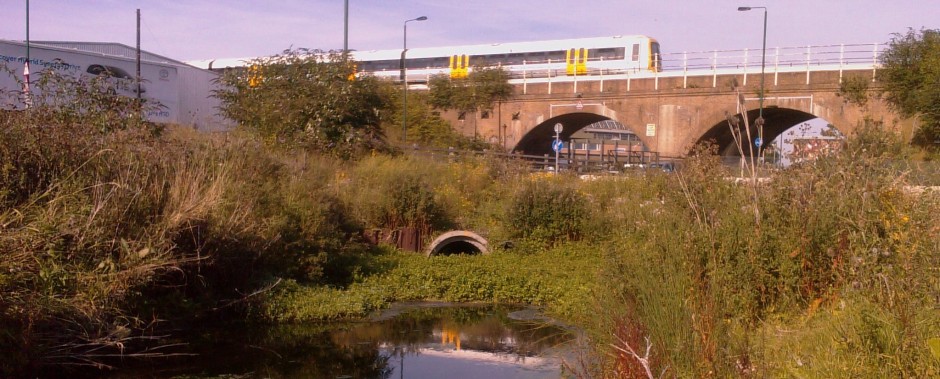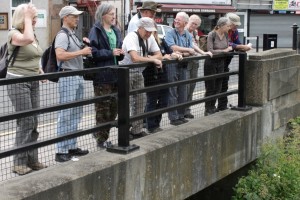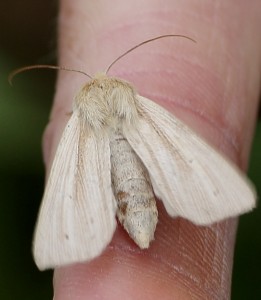Eleven members of Friends of Crossness Nature Reserve, and a member of the (River) Quaggy Action Group, joined Site Manager Chris Rose on a visit to Thames Road Wetland on 30th June. The event was a follow-up to a talk Chris and River Cray Project Co-ordinator Michael Heath had given to FoCNR about their work last year.
The event started at Waterside Gardens, Crayford, reaching Thames Road Wetland via Footpath 106 and By-way 105 along the banks of the River Cray.
Adult Bryony and Harlequin Ladybirds, Small Tortoiseshell and Red Admiral butterflies, Crab spiders and numerous Banded Demoiselle Damselflies were seen en route, whilst plants such as Pineapple Mayweed (with its Pineapple scent when crushed) and White Bryony (the only native member of the Cucumber family) were discussed. The Deadly Nightshade, an infrequent plant in London, was admired near the River-keeper’s yard. Patches of Water Cress were confirmed as such, since the rather different appearance of the flowering plant to what you buy in shops threw some of the people present.
Soon after arriving at TRW Terry spotted a Ringlet butterfly on the Sewer Pipe Embankment, a new site record, and therefore yet another locality for this spreading species. And after everyone else had gone, Chris got his first Six-spot Burnet moth at the Wetland along with a single clump of Hairy St. John’s-wort (which from memory could also be new, or at least not formally identified before).
Having clambered over the Thames Road fence attendees were shown Brookweed in flower, a plant confined to only 2 or 3 sites in London.
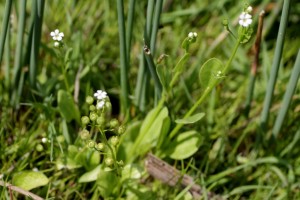
The Primula relative Brookweed (Samolus valerandi), a very rare plant in London, growing at Thames Road Wetland. (Photo: Martin Petchey).
A male Broad-bodied chaser Dragonfly was patrolling nearby over some open water which had been created by heavy Horse grazing of the otherwise dominant Great Reedmace. A couple of Lizards were observed basking on one of the now strategically placed old tyres that had been fly-tipped in the area some years ago.
The assembled throng were soon admiring the nationally scarce Marsh Sow-thistle at the first London reintroduction site for this species, which had been propagated from seed saved from the last colony in the capital. This had grown just 600m away on Crayford Marshes before allegedly being deliberately destroyed. The plants were already head and shoulders above all those present, and had very generously just come into flower.
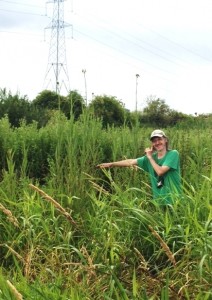
TRW Site Manager Chris Rose, standing in front of the towering Marsh Sow-thistles, briefs visitors about these statuesque plants. (Photo: Karen Sutton).
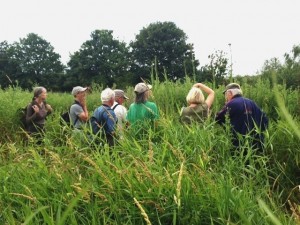
Some of the group getting up close and personal with the Marsh Sow-thistles. Even botanists have to look skywards sometimes …. (Photo: Karen Sutton).
The nearby Harvest Mouse nest was also noted before moving on.
After a bit of a struggle through the vigorous vegetational growth of the last couple of weeks, London rarities Cyperus (Hop) Sedge and Square-stemmed St. John’s-wort were looked at before the meeting came to an end.
All in all a good event which enabled Friends of Crossness members to get a feel for this much smaller ‘sibling’ of their own site at Erith Marshes, which never-the-less hosts a wealth of wildlife including a number of species that are rare in London as a whole, or Bexley, and that do not occur on their own patch.
For more information about Thames Road Wetland, please see the links under the ‘Places’ tab on this website.
